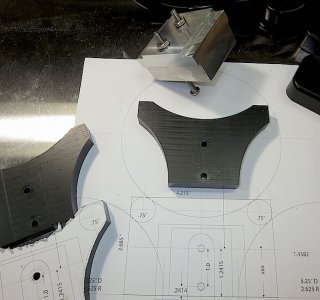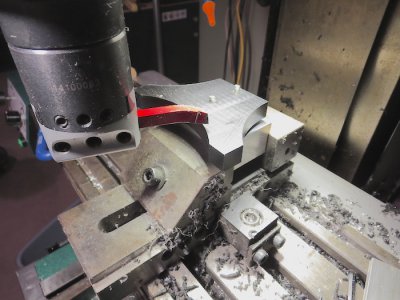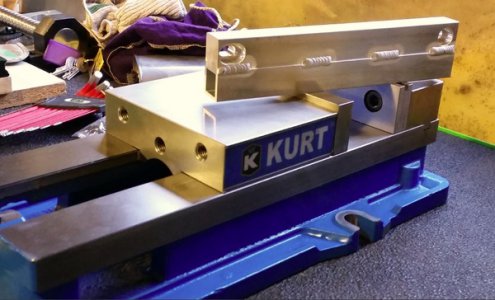[Peter's post slipped. I let this one sit all night before posting. The opening remark has nothing to do with Peter's last response.]
I'd rather talk about whirling sharp blades and powerful machines.
This is what I did today. They are just started but the three main cuts are finished. The aluminum piece in the back is the fixture I made to hold the parts while cutting the curves with a fly cutter. I thought I'd be able to make the part with just axis, but something went wrong and I ended up gluing the plan to one of the parts and just moving it until it matched the arc of the bit.

Here is a shot of the thing on the mill. It is just posed. The screws had nuts and washers when I was cutting.
I had a hard time finding a bit that would work. All the round boring bits I have cut right handed, except when chucked in the vertical bit holder. I tried cutting backwards, but the head of the boring head is screwed on the collet. Running it in reverse unscrewed it pretty quick. I didn't ruin anything and I learned to never try that again.
I found a braised set of lathe bits with a slightly smaller than 3/8" square shaft. I was able to mount that in the round vertical mount on the boring head, secured with 2 of the three set screws. It worked ok. I thought I was screwed there for a while.

The fixture has notches to hold it above the jaws, and relief cuts to allow room to run the fly cutter off the bottom. Everything must have been secured enough, as there was a lot of bumping while the bit was attacking the part.
Tomorrow I have to decide how to round the ends. If all else fails, I'll screw it to some MDF, shape the MDF on the router, remove the MDF pattern and round the ends on a sander. Then put it back on and us it for the template for a straight router bt with a bearing.
Once the corners are rounded, I'll soften all the edges with a 1/4" round-over bit on the router table.
Then, I can start on the 3/4 x 14 x 1/4 aluminum bars that will needed to bended into a C shape for the bracket.
The client want 2 of them. I'm making an extra to experiment on, and possibly screw up. If I don't screw it up, there is a good chance they'll order another one sometime soon.





